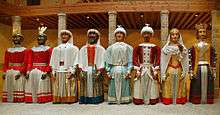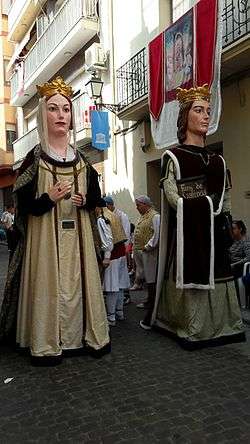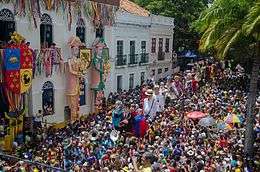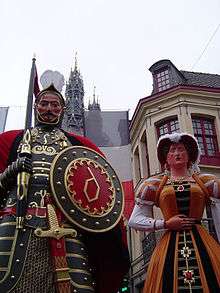Gigantes y cabezudos
Gigantes y Cabezudos (Portuguese: gigantones e cabeçudos; Valencian: Gegants i cabuts; Catalan: gegants i capgrossos; Basque: erraldoi eta buruhandiak; English: Giant and big-headed) are costumed figures in Spanish and Portuguese festivals. The main feature of these figures is typically their papier maché head; bodies are covered in clothing matching the costume's theme.
Origin
The first registered date for the gigantones e cabeçudos is the Corpus Christi festivity in Évora, Portugal back in 1265.[1][2] It included the snake, the demon and the dragon which represented the challenges that Jesus Christ had to defeat.
Gigantes

The giants are usually hollow figures several meters tall, with a painted paper maché head and arms, the rest of the body being covered in cloth and other clothing. Their frame is usually made of wood or aluminum, with carton-pierre—a mixture of papier-mâché and plaster of paris— used to make the head and hands. The frame of the body is hidden by cloth, and the arms typically have no structural element to allow them to swing in the air when the giant is turned.
Within the frame is an individual controlling the giant. He carries a harness on his shoulder that is linked to the internal structure, and will move and shake the giant in a dance, usually accompanied by a local marching band. Typically, these dances will include at least two giants, the male gigante and the female giantess, called giganta or gigantona, though some towns have multiple couples.
The figures usually depict archetypes of the town, such as the bourgeois and the peasant woman, or historical figures of local relevance, such as a founding king and queen, or pairs of Moorish and Christian nobles.

Cabezudos
Cabezudos are smaller figures, usually to the human scale, that feature an oversized, carton-pierre head. The heads are worn with a matching costume. The person dressed as cabezudo will use one hand to hold his head, while the other hand carries a whip or pig bladder, used to frighten children or young women. Seeing through the "mouth" of the head, he will chase after these people, though he might pause to calm a frightened child.
As with the giants, the cabezudos typically represent archetypes of their town.
Other fiesta figures

- Bonecos de Olinda, Brazil
- Celedón
- Gargantua
- Joaldun
- Judas and Judesa
- Mari-Jaia, gigante of modern fiestas of Bilbao
- Olentzero
- Paliqueiro, a kind of Galician cabezudo
- Peropalo
- Toro de fuego
- Zaldiko
- Zanpantzar
Zarzuela
Gigantes y cabezudos is also the title of an 1898 zarzuela, with music by Manuel Fernández Caballero, set in Saragossa and featuring a contemporary event: the Spanish army's return from the disastrous defeat of the Cuban War of Independence. The action unfolds during the festival of the Fiestas del Pilar, and concludes with a rousing jota focusing on the stereotypically strong, hardy character of the Aragonese, comparing them to the ever-battling "Gigantes" and "Cabezudos".
Gallery
 Gigantes of Barakaldo, Spain
Gigantes of Barakaldo, Spain


References
- Festividades cíclicas em Portugal (2. ed.). Publ. Dom Quixote. 1995. ISBN 9789722003353.
- "Giant Figures". 2017-07-10.
External links
| Wikimedia Commons has media related to Figures of giants. |